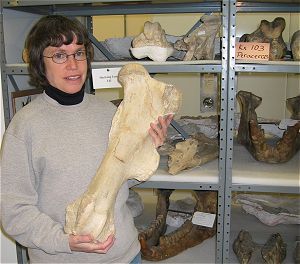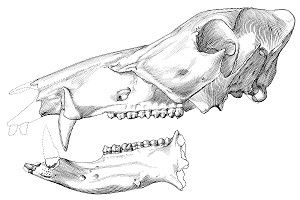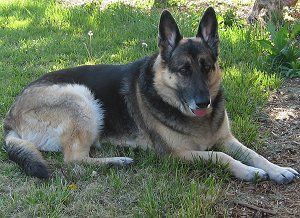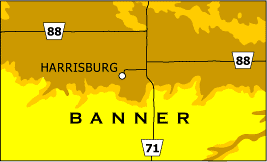
Nebraska County Fossils
Banner
< Vertebrate Paleontology Home
A virtual journey through the Museum's vertebrate paleontology collection.
Peraceras crassus, Rhinoceros
Family: Rhinocerotidae
Geologic age: Miocene (Barstovian), about 14 million years old
Year fossil collected: 1937


Peraceras was another of the large rhinos that inhabited Nebraska during the Miocene. Sediments in Banner County have produced a wonderful sample of these animals. Nebraskan scientist and author Loren Eiseley wrote about his 1930s experiences working these Banner County sites in his book The Night Country. Above, preparator Ellen Stepleton holds a femur (thigh bone) of Peraceras. She is standing in front of shelving units holding many additional rhino specimens from Banner County.
"Aptenohyus" xiphidonticus, Sword-toothed peccary
Family: Tayassuidae
Geologic age: Miocene (Barstovian), about 14 million years old
Year fossil collected: 1982


With canine teeth like this, you might think that this jaw belongs to a vicious carnivore, but it doesn't! Sometimes large canines are for defense, rooting for food, or simply display, rather than for capturing prey. Peccaries have rounded cusps on their molars, an adaption for a varied (omnivorous) diet. Human molars and peccary molars are quite similar, a fact that years ago misled some people to think that they had found a 10 million year old human fossil in Western Nebraska (oops, it was just a peccary!)
Aelurodon wheelerianus, Wheeler's Cat-toothed dog
Family: Canidae
Geologic age: Late Miocene (Barstovian), about 14 million years old
Year fossil collected: 1947


Aelurodon was a common carnivore during Miocene times and is found in most deposits of this age across Nebraska. It may have looked much like a German shepherd (left) or wolf and probably had a similar life-style. Unlike the modern wolf, however, Aelurodon was not the "top dog" of it's time. Canids have been important predators in North America for more than 40 million years.
Geological Ages of Rock Formations

| Q | Pleistocene ("Ice Age") Sands, gravels, silts overlay much of the county (not shown) Pleistocene sands, gravels and silts overlay much of Nebraska and often conceal the bedrock beneath. These "Ice Age" deposits often produce the remains of mammoths, bison, horses, musk oxen, elk and other familiar mammals. Small fossils, especially, are important indicators of the climate at the time of deposition. |
| Tpo | Tertiary, Miocene/Pliocene, Ogallala Group, 2-14 million years old Ogallala Group rocks include predominantly clastic sands and sandstones composed of a mixture of Rocky Mountain debris and locally derived and re-worked sediments. Ash beds are not unusual in the Ogallala and help to precisely date the sediments. In western and southwestern Nebraska, the Ogallala beds are responsible for resistant bluffs that cap the valley sides of modern streams. |
| Tm | Tertiary, Miocene, Hemingford/Arikaree Group, 15-28 million years old The Hemingford/Arikaree group includes the Miocene Sheep Creek, Upper Harrison, Harrison, Monroe Creek and Gering Formations. These rocks typically form the higher relief ridges as seen throughout the Pine Ridge area of Nebraska. These fine to medium grained sandstones contain considerable volcaniclastic material and indicate high volcanic activity in the west. Fossils from these rocks document the transition from a forest habitat to an open grassland habitat. |
| To | Tertiary, Oligocene, White River Group, 28-40 million years old The White River Group rocks include the Chadron and Brule Formations often form large expanses of low to medium-relief badlands typical of western Nebraska (Toadstool Park) and South Dakota (Big Badlands). Siltstones and very fine sandstones dominate these units. The White River Group rocks preserve the early history of horses, rhinos and camels, all of which originated in North America. The habitats across much of the state at the time were distinctly un-Nebraskan, with low-crowned browsing mammals (forest dwellers) and their predators composing the dominant fauna. |





